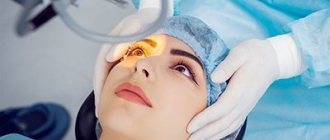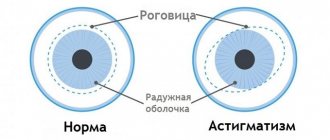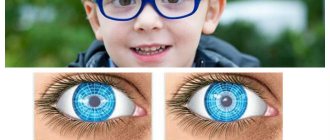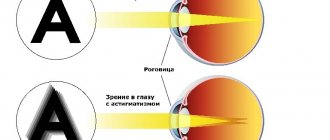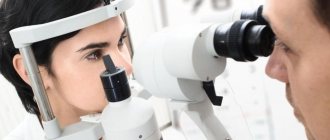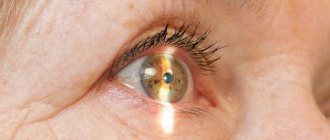For patients diagnosed with astigmatism, laser surgery is one of the possible treatment options. Surgical intervention is justified if:
- a person wants to stop depending on glasses;
- experienced intolerance to contact lenses;
- cannot correct vision by 100% with them;
- has a high degree of astigmatism;
- combines this diagnosis with farsightedness in the anamnesis.
Manipulations are carried out from the age of 18 in the absence of contraindications and changes in refraction over the past year.
How does astigmatism manifest?
An eye without refractive error is called emmetropic. The light rays are focused at one point on the retina, creating a full-fledged, clear image.
With astigmatism, the rays cannot focus at one point on the retina; two foci are formed, which can be located at different distances, both in front and behind the retina. The combination of the location of the foci relative to the retina largely determines the classification of astigmatism. In fact, the image that forms on the retina is not the same at every point, and the object appears elongated, altered. For example, a circle will look like an ellipse. This anomaly is usually congenital and has a genetic origin. It can also occur after injury, infection, or corneal pathology such as keratoconus.
Often, astigmatism is first diagnosed during a preventive examination or at an appointment with an ophthalmologist for another eye disease, so it is important to undergo diagnostic ophthalmological examinations, starting in childhood, for timely detection and prescription of the necessary correction of astigmatism.
Contraindications for laser vision restoration
Unfortunately, it is not always possible to perform laser correction of visual function. All contraindications to this operation can be divided into two large groups: temporary and permanent. Among temporary contraindications, the most common are those pathologies of the eye (or the body as a whole) that are reversible. After these diseases are cured, it is quite possible to perform laser correction. Temporary contraindications include:
- Progressive myopia, since the refraction is not stable;
- Acute inflammatory changes, both in the eye itself and in other body systems;
- Pregnancy;
- Lactation period;
- Changes in the fundus, including ruptures and dystrophic changes;
- Degenerative processes in corneal cells.
If there are constant contraindications, laser vision correction becomes impossible. These include:
- Thin cornea;
- Glaucoma;
- Lens subluxation;
- Retinal detachment;
- Cataract;
- Decompensated diabetes mellitus;
- Previous surgical treatment for retinal detachment.
Interestingly, even if there are absolute contraindications for laser vision correction, you can choose an effective alternative treatment method that will help restore vision.
Progress of the operation
Stages of laser correction for astigmatism:
- A person sits on a couch.
- Drops with an analgesic effect are instilled.
- An eyelid speculum is installed.
- A special ring is introduced to determine the center.
- A flap is formed to allow laser treatment of the cornea.
- Correction is performed using the selected technology.
- The corneal flap is returned to its place and, if necessary, fixed with a lens.
- The operated organ is treated with anti-inflammatory drugs.
It is advisable that a relative meet the person after treatment and help escort him home.
What are the symptoms of astigmatism?
Symptoms of astigmatism vary depending on its type, associated refractive errors and the age of the patient. If the astigmatism is mild, then the patient has no obvious complaints, especially before the age of 25-30, although astigmatism may go unnoticed even at a later age.
The higher the degree of astigmatism, the more the patient perceives the image as blurred, altered or double. This does not depend on the distance of the object being viewed, nor on the involvement of accommodation in trying to obtain the clearest possible image.
If astigmatism is associated with hypermetropia, then when working near the patient may experience eye fatigue, redness, dizziness or headache and other asthenopic complaints.
Typical complaints of patients with astigmatism:
- Blurredness and doubling of objects located both near and far;
- Excessively rapid eye fatigue;
- Possible headache with visual strain;
- Relative improvement of the image at a certain head rotation;
- Redness of the eyes;
- Eye irritation;
- Squinting your eyes to see the image more clearly;
- Decreased vision at night.
Prevalence of astigmatism
It is estimated that detectable refractive astigmatism is present in 95% of all people. However, refractive astigmatism in most of these cases will not be clinically significant. The incidence of clinically significant astigmatism has been reported to be 7.5-75% (!), which varies widely depending on the specific study and the author's definition. Research has shown that approximately 44% of the population has low astigmatism greater than 0.50 D, 10% of the population has greater than 1.00 D, and 8% of the population has high astigmatism 1.50 D or greater. Astigmatism can also be found in 22% of patients with Down syndrome.
Service cost
Depending on the method of laser correction of astigmatism, the clinic, and the degree of complexity of the disorders, the cost will vary. Minimum cost 25,000–30,000 rubles.
Laser vision correction for astigmatism is a highly effective technique for restoring visual functions. The risks of complications are extremely low, there is no pain. After treatment, you can completely forget about the problem of blurred vision.
Share the article on social networks. Tell us about your impressions of laser vision correction for astigmatism. Be healthy.
What are the types of astigmatism?
Astigmatism can be:
- simple - emmetropia is diagnosed in one of the meridians, and hypermetropia or myopia in the other;
- mixed - characterized by manifestations of myopia in one meridian, and hypermetropia in the other;
- complex - hypermetropia or myopia of varying degrees is diagnosed in both meridians.
According to the mechanism of occurrence, astigmatism is divided into:
- congenital;
- acquired.
In some cases, the cause of astigmatism may be associated not only with abnormalities of the cornea, but also with abnormalities of the lens, and there may also be distortion of perceived objects due to pathology of the central zone of the retina, which must be taken into account during the diagnostic examination of the patient.
Therefore, according to the location they are distinguished:
- Corneal astigmatism (most common);
- Lens astigmatism.
Contraindications
Treatment of astigmatism using a laser system has a number of limitations:
- Rapidly progressive myopia or hypermetropia;
- Ophthalmological abnormalities in the acute stage, characterized by inflammatory processes (for example, glaucoma or cataracts);
- Diseases of the endocrine system;
- Pregnancy and lactation period;
- Age less than eighteen and over forty-five years of age.
In the latter case, exceptions are possible; the final decision is made by the doctor after conducting a detailed diagnosis.
What is astigmatism?
This definition hides a violation of the refractive abilities of the visual apparatus, in which the shape of the cornea or lens changes or “potholes” appear on their surface. Patients with this diagnosis see the world around them vaguely, without clear contours.
Astigmatism is accompanied by rapid eye fatigue, light intolerance and headache. Symptoms clearly manifest themselves with prolonged stress on the visual apparatus.
In pathology, the curvature of the surface of the cornea has different indicators. This leads to an uneven and incorrect distribution of light fluxes on the retina, as a result of which the brain forms an incorrect image of surrounding objects.
The disease manifests itself under the influence of external factors or is congenital in nature.
What diagnostics are performed for astigmatism?
Diagnosis of astigmatism is carried out during an ophthalmological examination with the obligatory determination of visual acuity without correction and under conditions of optimal correction. There are many ways to diagnose astigmatism:
- The Snellen chart is used to test visual acuity;
- Optotypes for determining astigmatism;
- The autorefractokeratometer allows you to measure the optical power of the eye and the astigmatic component;
- Biometer is an optical device for measuring various structures of the eyeball, including indicating the presence of astigmatism;
- Keratotopograph is a device capable of accurately measuring the parameters of the cornea at each point on both the front and back surfaces, which is a unique diagnostic criterion;
- Keratometer , used to measure the curvature of the cornea;
- A subjective refractive test is necessary to obtain proper confirmation of astigmatism;
- Optical coherence tomography of the cornea.
Why does vision decrease?
Refraction refers to the optical power of the entire eye. Refraction is usually expressed in diopters. When this function is impaired, visual acuity decreases, which leads to a decrease in quality of life.
Astigmatism, myopia and farsightedness in all cases are accompanied by a decrease in visual acuity. Any refractive error leads to the fact that the focal point of the rays is not located in the plane of the retina, but in front of or behind it. Therefore, such patients require correction of visual function using external optical devices (glasses or contact lenses). This need can cause some inconvenience and is sometimes unsafe.
Among the diseases accompanied by refractive error, myopia is the most common. According to statistics, a third of all inhabitants of the Earth suffer from myopia. This disease can be diagnosed at any age, but most often patients with myopia are diagnosed at the age of 8-16 years. In the future, the disease may stabilize or continue to progress. In any case, myopia affects the quality of life, causing discomfort to the patient, and therefore requires close attention from specialists.
It should be noted that any visual impairment requires mandatory correction. Many people believe that when using glasses to correct vision, visual acuity decreases, but this is not true. On the contrary, if you do not use any correction methods, your eyes may stop working, which will certainly lead to amblyopia over time. In this case, even with perfect vision correction, it will not be 100%
How can astigmatism be corrected?
The most effective methods for correcting astigmatism are:
- Temporary or reversible correction of astigmatism (spectacle or contact correction),
- Permanent (surgical).
The last category includes various methods of excimer laser refractive surgery, including femto-assisted surgery (PRK, LASIK, REIK, FEMTO LASIK).
If it is impossible to use laser operations, implantation of toric phakic lenses or implantation of intraocular toric lenses is performed. Thanks to these innovative methods, it is possible to change the shape of the cornea and correct not only astigmatism, but also other associated visual impairments (myopia, hypermetropia). During a diagnostic examination, our ophthalmologist will determine individually which method of astigmatism correction is most suitable for each patient.
What is temporary correction of astigmatism?
Astigmatism can be corrected temporarily or permanently. Temporary correction of astigmatism involves the use of contact lenses or glasses. The optical design of a spectacle glass or contact lens allows you to take into account all the nuances of the redistribution of diopters along various meridians. However, spectacle and contact correction of astigmatism have both their positive aspects and disadvantages. Wearing glasses or contact lenses often causes discomfort and headaches - the eyes quickly get tired or cannot adapt to the new correction at all.
Glasses are absolutely indispensable for the patient and give him the opportunity to have good vision, but over time they can become uncomfortable, annoying for those who have to use them daily and depend on them.
Contact lenses are more convenient, but also have a lot of disadvantages and, in addition, can lead to pathology of the cornea, conjunctiva, eyelids, and cause dry eye syndrome. However, today you can take a different path and restore your vision using laser vision correction surgery and forget about addiction and poor vision forever.
What is permanent astigmatism correction?
Astigmatism can be permanently corrected, thereby ensuring the patient's visual acuity remains consistently high. Intervention for the final correction of astigmatism is performed using PRK, LASIK, REIK, FEMTO LASIK techniques and is recommended for those who have any degree of astigmatism, as well as any other visual anomalies.
For the final permanent correction of astigmatism (and any other associated visual defects) in our clinic, ophthalmic surgeons use the best surgical and laser equipment of the latest generation, high-tech techniques and safe, uniquely accurate femtosecond and excimer lasers.
The combination of two advantages - the best equipment and highly qualified surgeons - undoubtedly gives an excellent result: high visual functions and improved quality of life.
Laser treatment of astigmatism is indicated for patients with refractive disorders of the optical functions of the eye. It is correction using a laser beam that allows you to eliminate all visual optical disturbances and return good vision to the patient.
Vision correction for astigmatism with glasses and lenses
Correction of astigmatism with glasses is often carried out when the disease is mild. In this case, “complex” glasses with special cylindrical lenses are used. Ophthalmologists claim that wearing these optical products by patients with a high degree of astigmatism often leads to dizziness, pain in the eyes, discomfort and other unpleasant phenomena. When drawing up a prescription for the purchase of such glasses, the specialist, in addition to diopters, also indicates data on the cylinder and the axis of its location.
When listing methods for correcting astigmatism, it is, of course, worth paying attention to contact lenses. For this purpose, special toric models have been developed that have two optical powers (horizontal and vertical). One of them is aimed at correcting astigmatism, and the second is aimed at correcting concomitant visual pathology (farsightedness or myopia).
Many patients prefer contact correction devices because they provide higher quality central and lateral (peripheral) vision, as they are placed directly on the cornea. In addition, the lenses do not compress the bridge of the nose, do not change the appearance and do not fog up in adverse weather conditions, like glasses.
Popular lenses for correcting astigmatism:
- Air Optix for Astigmatism (Alcon). Monthly contact lenses with high wettability. Provide maximum comfort during use and take care of eye health. The oxygen permeability of these optical products is 138 Dk/t.
- Oasys for Astigmatism with Hydraclear Plus (Acuvue Series by Johnson & Johnson). Bi-weekly optical products that can be worn flexibly, daily or extended wear. They have a high level of oxygen permeability (129 Dk/t).
- Biofinity Toric. Thin and elastic lenses designed for people with increased sensitivity of the cornea. Designed for use within 1 month. They are practically not felt on the eyes during operation.
- Biomedics Toric (CooperVision). These lenses provide good stability on the eye by reducing rotation during blinking. Resistant to protein and other deposits. Designed to be worn for 1 month.
Laser treatment
Today, many surgical methods are used. This includes keratoplasty, microsurgery, and so on. But the most popular method is laser correction. It is as safe and painless as possible, since the shape of the cornea is restored by burning the organ, which makes the surface smooth.
But there are several techniques in laser therapy. This could be Lasik, PRK, Femto-Lasik, REIC. In a word, there are many of them, but only a doctor can choose the procedure that suits you.
How are they different from each other? Just a method of influence, but the essence of the treatment is the same. During laser surgery, the optical properties of the visual apparatus and other parameters must be taken into account. The correction does not take much time and does not have a rehabilitation period, since the patient can go home immediately after the operation. But for a month it will be necessary to limit the carrying of heavy objects, not to visit the bathhouse, not to take an excessively hot bath and not to drink alcohol.
Classification of astigmatism
There are three main types of astigmatism.
- Myopic astigmatism. One or both of the main meridians of the eye are myopic. If both meridians are myopic, they are usually myopic to varying degrees.
- Hypermetropic (far-sighted) astigmatism. One or both main meridians are farsighted. If both are farsighted, they tend to be hyperopic to varying degrees.
- Mixed astigmatism. One main meridian is nearsighted and the other is farsighted.
Astigmatism is also classified as regular or irregular. In ordinary astigmatism, the principal meridians are 90 degrees apart and perpendicular to each other (simple astigmatism). With irregular astigmatism, the main meridians are not perpendicular (compound astigmatism).
In most cases, astigmatism is a regular corneal astigmatism that gives the front surface of the eye an oval shape.
Irregular astigmatism can result from trauma to the eye that scars the cornea, some types of eye surgery, or keratoconus.
What are the indications for laser vision correction?
Laser correction or correction of astigmatism is indicated:
- patients with astigmatism up to 6 diopters;
- patients with vision problems aged 18 to 50 years;
- patients with intolerance to spectacle correction;
- patients at risk of developing dry eye syndrome who use contact lenses;
- professional athletes or people who work in certain areas that require high-precision vision without the possibility of using temporary correction devices;
- patients with anisometropia.
In the above situations, laser treatment of astigmatism will be effective and will help the cornea acquire the correct spherical shape, eliminating the manifestations of astigmatism and obtaining high visual acuity, which will significantly improve the quality of life.
It is important to know! Taking into account the peculiarities of the development of the optical system of the eye in children, correction of astigmatism is carried out only for certain indications, exclusively by ophthalmologists specializing in working with children.
Myths
There are many myths about laser vision correction for astigmatism. Let's try to dispel them.
- "It hurts". Not really. The maximum that you can experience during laser correction and after it is a feeling of discomfort, as if something has got into the eye, increased tearing.
- "Hospitalization required." This is a myth; treatment is carried out on an outpatient basis. You will return home on the day of surgery.
- "Long recovery period." In fact, this is not so: vision is restored the next day after laser correction, and unpleasant postoperative symptoms only bother you for a few hours.
- “Other eye pathologies will arise.” The likelihood of developing other ophthalmological pathologies does not depend on whether laser correction of astigmatism was performed.
- “Laser is dangerous, which confirms that it is contraindicated for children.” Modern laser systems are safe for health. A competent specialist knows how to configure the necessary characteristics of the device so as not to cause harm. Children are not treated with laser for astigmatism due to the fact that the eye has not yet fully formed.
- “After laser treatment, you will need to limit your lifestyle.” It is not true. After correcting astigmatism with a laser, you do not need to limit yourself in anything. After the end of the recovery period, you can perform any physical activity, play sports, or work on the computer.
- “Women who have not given birth should not undergo laser correction.” This is not true: laser does not affect future pregnancies and births.
- “Vision will still deteriorate after laser treatment.” The long-term effectiveness of the treatment received has been proven. Changes from laser exposure do not occur inside the eye, so visual impairment will not occur again. The only thing is that, regardless of laser correction, you may develop other diseases that lead to vision deterioration.
- “Perhaps after treatment there will be no effect.” This is excluded, since the laser changes the refractive properties of the cornea, which inevitably leads to improved vision.
Benefits of excimer laser vision restoration
Vision correction using an excimer laser is a very common procedure that is in demand in all countries.
The advantages of the method include:
- Reliability of results;
- Painless;
- Speed of execution (no more than a quarter of an hour);
- Safety;
- Carrying out manipulations on an outpatient basis;
- Wide range of possibilities;
- Short recovery period;
- Predictable and predictable result with high accuracy;
- No cuts or seams;
- Simplicity and accessibility;
- No additional tests are needed;
- High efficiency that lasts for life.
It should be noted that, despite the wide possibilities of laser vision correction, this operation does not guarantee the absence of various eye pathologies in the future.
Surgical treatment of astigmatism
What techniques are used for surgical correction of astigmatism?
In our Clinic we use modern, safe, high-precision methods for correcting astigmatism such as LASIK, REIK, FEMTO LASIK, FEMTO REIK, FEMTO SUPERLASIK, FEMTO SUPERREIK.
All these techniques are based on the principle of intrastromal refractive surgery and consist in forming a flap from a thin surface layer of the cornea and further processing the layers of the cornea with a laser beam.
LASIK technique
LASIK correction is a reliable, effective and affordable way to restore quality of vision to patients. During surgery, the ophthalmologist creates a flap, then the corneal stroma is ablated with a laser beam.
REIC methodology
Correction using the REIC method is an innovative development of doctors at Dr. Kurenkov’s Clinic. It consists of eliminating refractive errors with high precision using an excimer laser.
After changing the shape of the cornea and returning the flap to its place, the eyes are treated with saline, which avoids contamination and deformation.
FEMTO REIC
With the FEMTO REIC technique, flap formation with the highest possible precision is performed using a femtosecond laser, which eliminates the use of a blade, providing access to the stromal layer of the cornea without any contact inside the cornea, on which it is necessary to perform photoablation with an excimer laser. Accuracy, smoothness and evenness (including the formed corneal bed) ensure the best result of the operation.
What are the advantages of the FEMTO REIC technique?
The FEMTO REIC technique has a lot of advantages, both objective and subjective. Here are some of them:
- it is a particularly safe and extremely precise operation thanks to the use of a femtosecond laser;
- this is a painless intervention: a few drops of anesthetic action are enough to undergo the operation calmly and painlessly;
- the risks in the intraoperative and postoperative period are further reduced. Complications are kept to a minimum, also thanks to the high level of sterility guaranteed by the laser beam;
- the operation does not involve the use of blades or scalpels - therefore, there is no contact impact and inaccuracies;
- Postoperative recovery is faster than with other surgical methods.
This technology has the following advantages:
- safety and painlessness of correction;
- lack of postoperative dressing;
- the ability to predict the result before surgery;
- stability of the result obtained;
- preservation of the anatomical features of the outer shell of the eye;
- possibility of performing correction on both eyes at once.
Treatment methods
Treatment of astigmatism in adults can have different directions. It may require immediate surgical intervention, or may involve wearing contact lenses, adjusting your diet, and taking medications. According to qualified doctors, the eye pathology in question can be completely eliminated only through surgery.
However, before prescribing such a serious step as lying on the surgical table, ophthalmologists prefer to try everything, even the most conservative methods.
Such therapy becomes possible only if the patient has time to spare. In case of sudden and significant changes in the normal functioning of the eyes, the only prescription of specialists is an immediate consultation with a surgeon regarding preparation for an emergency operation.
Contact lenses. Choice of lenses, cost
Contact lenses are one of the simplest methods of restoring normal functioning of the visual organs. To treat astigmatism, lenses with a toric surface are used. They can slightly correct the shape of the lens and cornea.
Treatment of astigmatism in adults can be reduced to the use of contact lenses.
The “strengths” of this method of correcting astigmatism are:
- the ability to correct even the most “advanced” stage of the disease;
- maintaining the real field of view when perceiving a picture with the retina of the eye;
- ability to correct in both eyes at once;
- minimal presence of prismatic effect.
Despite the advantages, contact lenses of this type are not without disadvantages.
Among the most significant of them are:
- the occurrence of inflammatory diseases (due to improper storage, individual reaction of the body, and so on);
- worsening of secondary diseases caused by astigmatism (for example, farsightedness or myopia);
- actual change in the shape of the cornea, often leading to errors in the selection of methods for treating astigmatism in the future;
- the formation of significant changes in the shape and structure of the visual organs (in the vast majority of cases, this becomes a reason for surgeons to refuse to perform surgery to correct the vision of a particular patient).
When choosing contact lenses, you must first undergo a comprehensive examination in the salon where you plan to purchase them. This is due to the fact that such correction methods are selected taking into account the individual structural features of the eyes, face and the characteristic features of the pathology itself. Having carried out the appropriate diagnostics, the in-house doctor at the optical salon will advise the most suitable option.
The average cost of high-quality contact lenses for correcting astigmatism is 3 – 4 thousand rubles. Savings in this case are not advisable, since in most cases the price of lenses is determined by the quality of the material used in their production, as well as their compliance with the requirements of specialists.
Nutrition. Allowed and prohibited foods, diet principles
Treatment of astigmatism in adults requires lifestyle changes, including dietary adjustments. This is not about following strict diets. In the vast majority of cases, strict dietary restrictions not only do not have a positive effect on human health, but can also greatly undermine it.
To minimize the risk of a “reverse effect”, a patient with astigmatism should avoid dishes that contain:
- fried ingredients;
- fatty meats, cheeses;
- a large number of hot seasonings;
- a lot of salt or sugar;
- Wheat flour;
- preservatives.
In such a situation, you should also refuse:
- alcoholic drinks;
- smoking;
- semi-finished products.
To strengthen the visual muscles, it is advisable for the patient to include in his diet:
- nuts;
- carrot;
- beet;
- bell pepper;
- cabbage;
- citrus fruit;
- apples;
- bananas;
- berries of all varieties and compotes or fruit drinks made from them;
- fermented milk products (kefir, fermented baked milk, cottage cheese, etc.);
- stewed fish (preferably white);
- lean meat (beef, veal, chicken);
- spinach;
- dill;
- parsley.
According to doctors' recommendations, the daily amount of food should be divided into 4-5 meals with an interval of at least 3 hours. It is extremely important to monitor the amount of water you drink. It should be at least 1.5-2 liters per 24 hours.
Pharmacy drugs. Names, medication regimen
With early stage astigmatism, there is a chance to correct the situation with drug treatment.
Most often, ophthalmologists prescribe to patients with this disease:
| Medicine | Reception scheme and description |
| "Albucid" | Eye drops with the main active ingredient sodium sulfacetamide. It is usually prescribed to eliminate eye infections. According to the instructions, the drug in question must be instilled under the eyelid, 1-2 drops 5-6 times a day, depending on the direction of treatment. The duration of the course of taking this pharmaceutical product should not exceed 28 days, while visible improvement is already observed after 10 - 12 days. |
| "Taufon" | The main component of this drug is taurine. It is especially effective for retinal dystrophy, as well as cataracts and injuries to the visual organs. Typically, the drug in question is prescribed for instillation into the eye, 1-2 drops 3-4 times a day for 2-3 months. After such a course, a break is necessary, followed by resumption of treatment. |
| "Quinax" | The basic component of this metabolite is sodium polysulfonate. Doctors recommend using it when it is necessary to normalize metabolic processes in the lens. It is not prohibited for long-term use. The daily dosage usually does not exceed 3-4 instillations of 1-2 drops. |
Despite the mild action of such medications, if used indiscriminately, they can negatively affect the condition of the eye mucosa (most often dry out).
Surgical intervention. Indications for surgery, preparation and implementation, cost
Despite the fact that surgery is one of the most effective methods of combating astigmatism, it is impossible to prescribe it without indications.
Reasons for surgery may include:
- low efficiency in correcting astigmatism using conservative methods or its absence;
- rapid deterioration of the patient’s vision and the transition of the current disease to its severe form.
The operation itself is a step-by-step process of correcting injured lenses.
This can happen in several ways:
- cauterization using a heated metal needle (thermokeratocoagulation) - average price - 15-20 thousand rubles per eye;
- using a laser (laser coagulation) - average price - 18 - 22 thousand rubles per eye;
- by dissecting the cornea (keratotomy) – 20 thousand rubles per eye;
- filling the voids of the cornea of the eye (laser correction) – 22-25 thousand rubles for 1 eye.
Depending on the type of operation, the doctor will warn the patient about the need for special preparation for it. This usually means taking blood and urine tests, ultrasound and other narrow studies of a person’s health status.
Physiotherapy. Set of exercises
Therapeutic exercises are no less often prescribed by ophthalmologists to correct astigmatism.
The set of exercises is simple and does not require much time to complete:
| Exercise | Description of the technique |
| "Rotations" | With your eyes wide open, you need to describe circles alternately clockwise and counterclockwise. Then draw horizontal and vertical lines. At the final stage - reduce it to the bridge of the nose. This exercise requires at least 1 minute. |
| "Dot" | Raise your gaze upward, stretching your eye muscles as much as possible. Maintain the resulting position for 10-15 seconds. Relax, then repeat the exercise, directing your gaze alternately down, right and left. |
| "Clap for speed" | Blink your eyes as quickly as possible for 20 seconds, then close your eyes tightly. Hold the position for 10 seconds and repeat the exercise. |
Such exercises will give results only if they are performed daily.
Folk remedies. Recipes and dosage regimen
In correcting the initial stage of astigmatism, traditional methods of combating the disease are popular.
Among them:
- Blueberry compote . Add 1 tbsp to 1 liter of boiling water. fresh blueberries. Mix thoroughly and cook over medium heat for 20 minutes. You can add sugar if desired. After the specified time has passed, remove the compote from the heat and cool. There are no restrictions on the daily amount of drink taken.
- Infusion of grape seeds . 2 tbsp. l. Mix the seeds with 200 ml of boiling water. Close the lid and leave for 2-3 hours in a dark place. Take 2 tbsp orally. l. 3 r/day.
- Infusion of eyebright . 3 tbsp. l. add dry herbs with ½ liter of boiling water. Keep on low heat for 2-3 minutes, then simmer and let it brew for 3 hours. Take the pre-strained infusion, ½ tbsp. 2-3 times a day for 1.5 - 2 weeks.
In the fight against diseases of the visual organs, the use of traditional methods will give results after a longer time than drug treatment will prove its effectiveness. However, natural remedies are much more gentle on the body. This minimizes the risk of them having a negative impact on your overall health.
Features and types of operations
Laser correction of astigmatism is performed using several methods.
LASIK (Opti LASIK)
LASIK technology consists of normalizing the refractive power of the cornea by changing its shape. To do this, the operating doctor creates and bends a corneal flap using a microkeratotome. This allows laser exposure to be applied to the deep layers of the cornea. At the end of the operation, the flap is placed in its original place.
The advantage of this correction option is that the superficial layers of the cornea are not affected. This allows you to maintain the transparency of the shell. LASIK is effective for disorders not exceeding 3 diopters.
Femto LASIK
Femto-LASIK technology is used in people with thinning corneas and xerophthalmia. The advantage of femtolaser treatment over LASIK is that the flap is formed using a knifeless method. There is no need to make an incision because the infrared rays of the femtosecond laser delaminate the cornea. The dissection boundary is as smooth as possible, which improves the results of the operation and shortens the recovery period.
Super-LASIK (Opti-Q LASIK)
The Super-LASIK technique is an improved version of LASIK. It involves the development of a surgical program that takes into account the individual characteristics of visual perception disorders. The doctor analyzes distortions of the human cornea and models ways to correct the pathology. Super-LASIK is used to treat higher order distortions, which include astigmatism.
LASEK (Opti LASEK)
The LASEK technique differs in its effect not on the deep, but on the superficial layers of the cornea. After the end of the laser treatment, a lens is put on the eye to fix it and speed up recovery. The lens is removed after 3–4 days.
LASEK is good because the technique is suitable for thinned corneas, and also because it does not affect the deep layers.
Super-LASEK (Opti-Q LASEK)
The essence of Super-LASEK technology is similar to Super-LASIK. A preliminary analysis is carried out using a special system. Laser treatment is performed only on altered areas of the cornea.
Photorefractive keratectomy (OptiPRK)
The PRK method involves removing the epithelium. The curvature of the cornea is then precisely modified using a laser. After this, a contact lens is installed for 3-4 days, which is then removed.
Photorefractive keratectomy is associated with a long and unpleasant recovery period, since a wound surface remains. PRK is performed if LASIK technology is contraindicated.
How is the operation performed?
Laser correction of astigmatism consists of three stages:
- A flap is formed on the cornea and placed to the side.
- Using a laser, part of the cornea is evaporated, giving it the correct shape, which can significantly improve the patient’s vision.
- After giving the cornea a spherical shape, the previously folded flap of tissue is returned to its place and tightly fixed without treating it with suture material, which can significantly speed up regeneration after the intervention.
Laser surgery for astigmatism in both eyes takes 10 to 12 minutes. The intervention is performed under local anesthesia and does not cause discomfort. Vision is restored a few hours after the operation, and regeneration takes only a few days, without requiring the patient to stay in the hospital.
Types of operation
Keratotomy
Keratotomy is a procedure for making incisions in the cornea. Before surgery, a comprehensive scan of the cornea is performed. The depth, length and location of the cuts are carefully calculated. The operation is performed under local anesthesia and usually lasts less than 5 minutes.
The surgeon cuts the patient's cornea directly with a scalpel. He applies peculiar notches to the fabric, thus changing the curvature of the refractive surface. As a result, this part of the cornea bulges under the influence of intraocular pressure and becomes narrower. This, in turn, changes its curvature. The operation has a fairly high rate of complications, so it is currently performed infrequently.
There are more modern modifications of it. It is possible to use tools with a diamond attachment, as well as a laser instead of a scalpel. In this case, the postoperative period is shorter, and the cornea heals faster. This method is practiced when insufficient thickness of the cornea prevents keratectomy (its partial removal).
Laser correction
The operation can be performed in two main ways - PRK (photorefractive keratectomy) and Lasik (laser-assisted intrastromal keratomyelosis). The first operation is used to correct mild forms of astigmatism. Lasik is suitable for correcting more serious forms of the disease (more than 3 diopters) and for concomitant farsightedness.
Laser intrastromal keratomyelosis is considered a more advanced technique. After it, complications are less common, the percentage of successful operations is slightly but higher, and it is also somewhat more accurate than PRK.
PRK
During this operation, the surgeon makes an incision into the epithelium and removes part of the tissue. It can be carried out with a scalpel, laser or using a chemical agent. Some installations allow you to do without this stage, in particular the Russian-developed device “Profile 500”.
Through the resulting hole, the laser beams reach the cornea. There, under their influence, the bonds between molecules and atoms are broken. As a result, the cornea is evaporated to the thickness required for correction.
Cost of the operation
It is most likely impossible to cure astigmatism for free. Most companies classify surgeries to correct it as cosmetic, which insurance does not cover. In some cases, the operation can be performed under compulsory medical insurance, for example, when a patient with cataracts has a prosthetic lens, he may ask to use a toric lens, which will also correct astigmatism. But in this case, he will have to pay for the prosthesis himself.
The price may vary greatly depending on the type of intervention (indicated for 1 eye):
- PRK. The cost starts from 8,000 – 10,000 rubles. In Moscow, the average price is 15,000 rubles. Many modern centers have already abandoned it.
- Lasik. This operation, on the contrary, is carried out everywhere. Its average price is 20,000 rubles. When using a laser of the latest development or new technologies, it can reach 35,000 - 40,000 rubles.
- Thermocoagulation. The procedure is not popular among modern ophthalmologists. The price can vary greatly in the capital and province. So in Voronezh the average cost is 2,000 - 3,000 rubles, and in St. Petersburg - 12,000 - 13,000.
- Corneal prosthetics. Using an artificial lens will cost an average of 50,000 rubles.
- Corneal transplant. Using living donor tissue will cost significantly more. Not every medical center performs such complex technological operations. At the Excimer clinic in Moscow, it can cost 160,000 or 210,000 rubles, depending on the modification of the technique.
- Implantation of phakic lenses. This operation is complex and requires the use of expensive prostheses. Its price can range from 50,000 to 100,000 rubles, depending on the clinic and the type of artificial lens.
- Implantation of a toric artificial lens. This procedure is more expensive than conventional prosthetics. If an operation using a nontoric lens costs 20,000 - 30,000 rubles, then with astigmatism you will have to pay from 50,000 rubles for the procedure.

